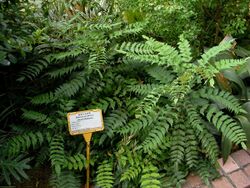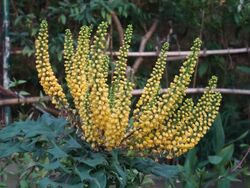Biology:Mahonia oiwakensis
| Mahonia oiwakensis | |
|---|---|

| |
| Mahonia oiwakensis | |

| |
| Flowers of Mahonia oiwakensis | |
| Scientific classification | |
| Kingdom: | Plantae |
| Clade: | Tracheophytes |
| Clade: | Angiosperms |
| Clade: | Eudicots |
| Order: | Ranunculales |
| Family: | Berberidaceae |
| Genus: | Mahonia |
| Species: | M. oiwakensis
|
| Binomial name | |
| Mahonia oiwakensis Hayata
| |
| Synonyms[2][3][4] | |
|
Species synonymy
| |
Mahonia oiwakensis is a species of plant in the barberry family, Berberidaceae. It is native to Taiwan, China ( Guizhou, Hong Kong, Sichuan, Xizang (Tibet) and Yunnan) and Myanmar, where it occurs at elevations of 600 to 3800 m.[2] It has recently been found naturalized in South Africa .[5]
Nomenclature
This species has long been known by the name Mahonia lomariifolia, published by Takeda in 1917.[6] Under that name, it was considered to occur only in mainland China, while on Taiwan, a second species was found, known as M. oiwakensis. Modern taxonomic sources unite the two as a single species,[2] but as the latter name was published a year earlier by Hayata,[7] it has priority and is thus the accepted name. In recognition of the morphological differences between the Taiwanese and mainland Chinese plants, Shaw[8] recognized the two as subspecies of Mahonia oiwakensis: M. oiwakensis subsp. oiwakensis in Taiwan and M. oiwakensis subsp. lomariifolia in mainland China. In addition, a plant collected in Yunnan with especially narrow leaflets was described as a new variety: Mahonia oiwakensis subsp. lomariifolia var. tenuifoliola.[8]
Description
Mahonia oiwakensis is a shrub or tree up to 7 m tall. Leaves are up to 45 cm long, compound with 12-20 pairs of leaflets plus a larger terminal one, dark green above, yellow-green below. The inflorescence is a fascicled raceme up to 25 cm long. The berries are egg-shaped, dark blue, sometimes almost black, up to 8 mm long.[2][7]
Hybrids
Mahonia oiwakensis subsp. lomariifolia is one parent of the important garden hybrid Mahonia x media, which includes popular cultivars such as 'Charity', 'Winter Sun' and 'Lionel Fortescue' (the other parent is Mahonia japonica).[9] It is also a parent of the cultivar 'Arthur Menzies', though with Mahonia bealei as the other parent.[10] In the wild in Taiwan, M. oiwakensis subsp. oiwakensis appears to hybridize with wild Mahonia japonica.[8]
Mahonia oiwakensis subsp. lomariifolia has gained the Royal Horticultural Society’s Award of Garden Merit.[11][12]
References
- ↑ Pan, F.J. (1998). "Mahonia oiwakensis". IUCN Red List of Threatened Species 1998: e.T34757A9887847. doi:10.2305/IUCN.UK.1998.RLTS.T34757A9887847.en. https://www.iucnredlist.org/species/34757/9887847. Retrieved 17 November 2021.
- ↑ 2.0 2.1 2.2 2.3 Flora of China v 19 p 774,
- ↑ Tropicos
- ↑ The Plant List
- ↑ Jaca, T. P. 2017. Chinese hollygrape (Mahonia oiwakensis): newly detected weed. South African Plant Invaders Atlas (SAPIA) News 45:2-3. Last accessed February 15, 2018, from http://www.arc.agric.za/ARC%20Newsletters/SAPIA%20NEWS%20No.%2045,%20July%202017.pdf.
- ↑ Takeda, Hisayoshi (1917). "Contributions to the Knowledge of the Old World Species of the Genus Mahonia". Notes from the Royal Botanic Garden, Edinburgh 6 (29–30): 209–248. https://www.biodiversitylibrary.org/item/100888#page/235/mode/1up.
- ↑ 7.0 7.1 Hayata, Bunzo (1916). "Contributions to the Flora of Formosa". Icones Plantarum Formosanarum Nec non et Contributiones Ad Floram Formosanam 6: 1–163. https://www.biodiversitylibrary.org/item/66589#page/15/mode/1up.
- ↑ 8.0 8.1 8.2 Shaw, Julian (2011). "Developments in Mahonia". The Plantsman. New Series 10: 44–49. https://www.rhs.org.uk/about-the-rhs/publications/magazines/the-plantsman/2011-issues/march/Developments-in-Mahonia.pdf.
- ↑ Brickell, C.D. (1979). "The hybrids between Mahonia japonica and M. lomariifolia". The Plantsman 1: 12–20.
- ↑ Witt, J.A. (1967). "Mahonia 'Arthur Menzies'". Arboretum Bulletin Washington Spring: 14–15.
- ↑ "RHS Plantfinder - Mahonia oiwakensis subsp. lomariifolia". https://www.rhs.org.uk/Plants/314114/i-Mahonia-oiwakensis-i-subsp-i-lomariifolia-i/Details.
- ↑ "AGM Plants - Ornamental". Royal Horticultural Society. July 2017. p. 62. https://www.rhs.org.uk/plants/pdfs/agm-lists/agm-ornamentals.pdf.
Wikidata ☰ Q5458401 entry


